🧪 ¿COMO HACER JABÒN? | 🧪 How To Make Soap?
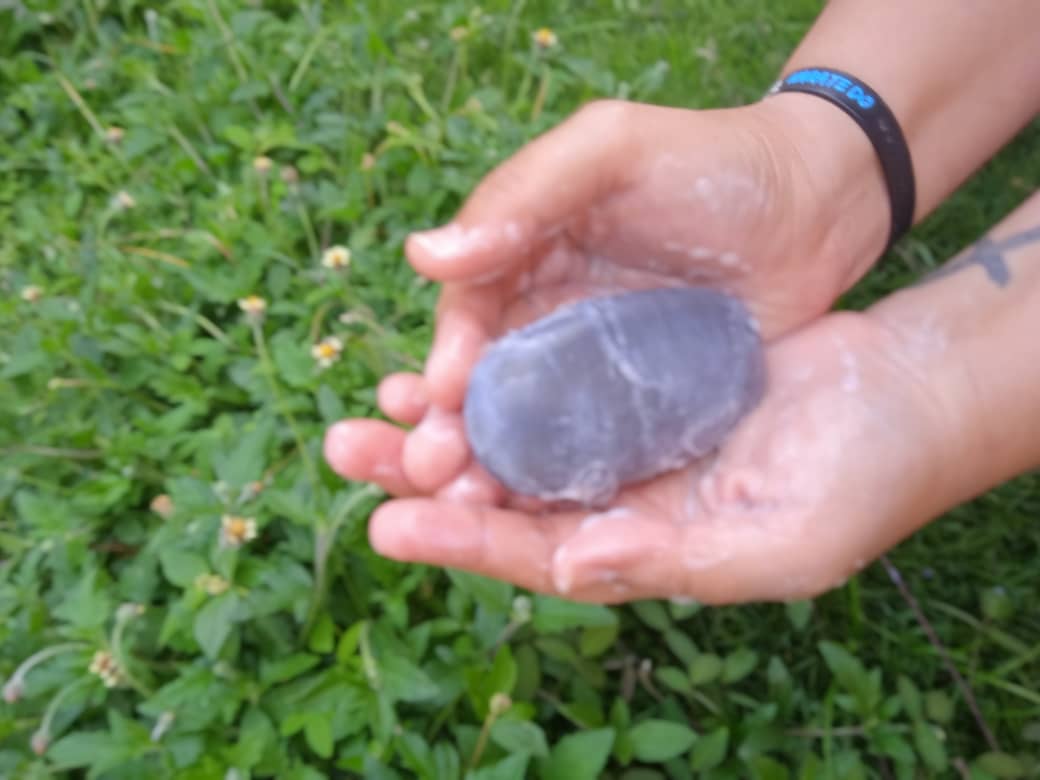

➝ ¡Saludos comunidad de Hive! Gracias por el recibimiento tan caluroso hace varios días, como lo prometido es deuda; acá les traigo este nuevo post en el que vamos a aprender a elaborar jabón casero, si amigos tal y como lo leyeron ¡Jabón! Eso que usamos a diario para múltiples tareas en el hogar y nuestra vida cotidiana.
Greetings Hive community! Thank you for the warm welcome, as promised is a debt; here I bring you this new post in which we are going to learn how to make homemade soap, yes friends, as you read it, soap! That which we use on a daily basis for multiple tasks around the home and our daily lives.
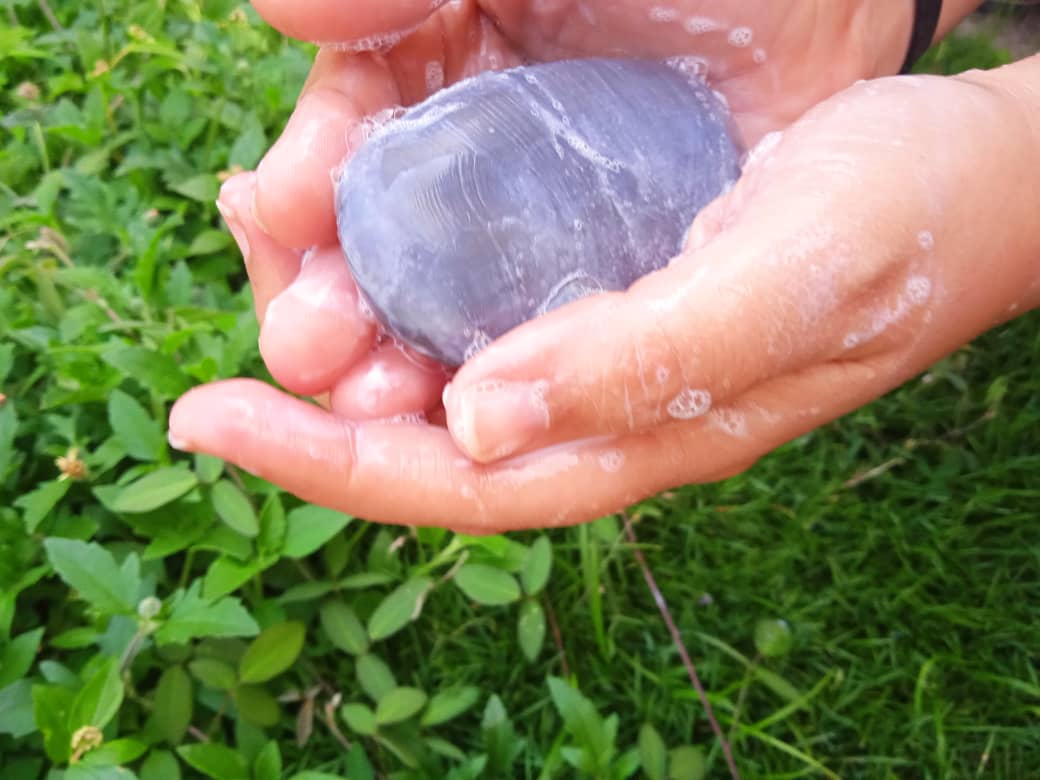
➝ Para adentrarnos un poco en materia, vamos a comentarles primeramente algo de teoría para entender el proceso de cómo ocurre la fabricación de este producto tan popular. El jabón se elabora por hidrólisis básica, con hidróxido de sodio (sosa cáustica) o hidróxido de potasio (potasa cáustica); y grasas animales o aceites vegetales (esteres de ácidos carboxílicos de cadena larga). La combinación de estos dos compuestos mencionados anteriormente (la sosa o potasa con la grasa o aceite) dan origen a la reacción conocida como saponificación; cuando se lleva a cabo este proceso se obtiene una sal del ácido graso llamada jabón y se libera glicerina.
To delve into the subject a little, we are going to first comment on some theory to understand the process of how the manufacture of this popular product occurs. Soap is made by basic hydrolysis, with sodium hydroxide (caustic soda) or potassium hydroxide (caustic potash); and animal fats or vegetable oils (long chain carboxylic acid esters). The combination of these two compounds mentioned above (soda or potash with fat or oil) gives rise to the reaction known as saponification; When this process is carried out, a salt of the fatty acid called SOAP is obtained and glycerin is released.

➝ Una vez dada una introducción sencilla sobre el proceso de elaboración del jabón, pasamos a la instrumentación básica que necesitaremos para hacer nuestro jabón en casa. Considerando que la saponificación es una reacción que se provoca a altas temperaturas, también se puede hacer sin necesidad de calentar la mezcla; pero debido a que la sosa caustica es altamente corrosiva, desprende mucho calor y humos tóxicos es necesario el uso de accesorios para nuestra protección en caso de algún accidente o tener conocimiento básico de que hacer en dado caso, por ello les dejo una tabla que en su momento elabore para realizar la practica en el laboratorio (importante ya que sin eso no podíamos presentarnos para hacer la práctica), en la misma tenemos medidas de prevención y la referencia bibliográfica de donde extraje las fichas de dichos compuestos.
Once given a simple introduction about the soap making process, we move on to the basic instrumentation that we will need to make our soap at home. Considering that saponification is a reaction that occurs at high temperatures, it can also be done without the need to heat the mixture; But because caustic soda is highly corrosive, it gives off a lot of heat and toxic fumes, it is necessary to use accessories for our protection in case of an accident or to have basic knowledge of what to do in any case, so I leave you a table that in its time elaborate to carry out the practice in the laboratory (important since without that we could not present ourselves to do the practice), in it we have prevention measures and the bibliographic reference from where I extracted the files of said compounds.

➝ Ya sabiendo esto, los accesorios recomendados para la realización de este procedimiento los tenemos a continuación; puede hacerlo sin seguir estrictamente esto pero esta bajo su responsabilidad algún accidente que se les pueda presentar.
• Guantes.
• Lentes (Si utilizas lentes de vista esos son suficiente, lo ideal es tener los ojos protegidos para cualquier salpicadura).
• Bata (Es opcional, en caso de no tener pueden usar una franela con mangas largas).
• Pantalón (Al igual que lo anterior es para cubrir la piel y evitar salpicaduras).
• Zapatos cerrados.
Knowing this, the accessories recommended to carry out this procedure are listed below; You can do it without strictly following this but it is under your responsibility any accident that may arise.
• Gloves.
• Glasses (If you use glasses, those are enough, the ideal is to have your eyes protected from any splashes).
• Robe (It is optional, if you do not have it, you can use a flannel with long sleeves).
• Trousers (Like the above, it is to cover the skin and avoid splashes).
• Close shoes.
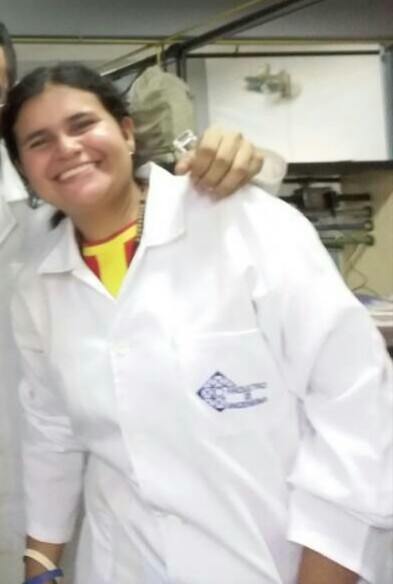
➝ Ahora bien, los instrumentos necesarios para realizar nuestro jabón son los siguientes:
• 3 envases de vidrio (anchos).
• 1 Olla.
• Batidora (Cualquier instrumento que sirva para batir sirve).
• 600g de Aceite (Puede ser cualquiera, pero en este caso usamos aceite de oliva).
• 80g de Hidróxido de Sodio (Sosa Cáustica).
• 200mL de Agua.
• Toalla.
• Termómetro.
• Paleta de Madera.
• Papel absorbente.
• Estufa (La cocina de tu casa).
• Molde.
Now, the instruments necessary to make our soap are the following:
• 3 glass containers (wide).
• 1 Pot.
• Mixer (Any instrument that is used to beat works).
• 600g of Oil (It can be any, but in this case we use olive oil).
• 80g of Sodium Hydroxide (Caustic Soda).
• 200mL of Water.
• Towel.
• Thermometer.
• Wooden pallet.
• Absorbent paper.
• Stove (The kitchen of your house).
• Mold.
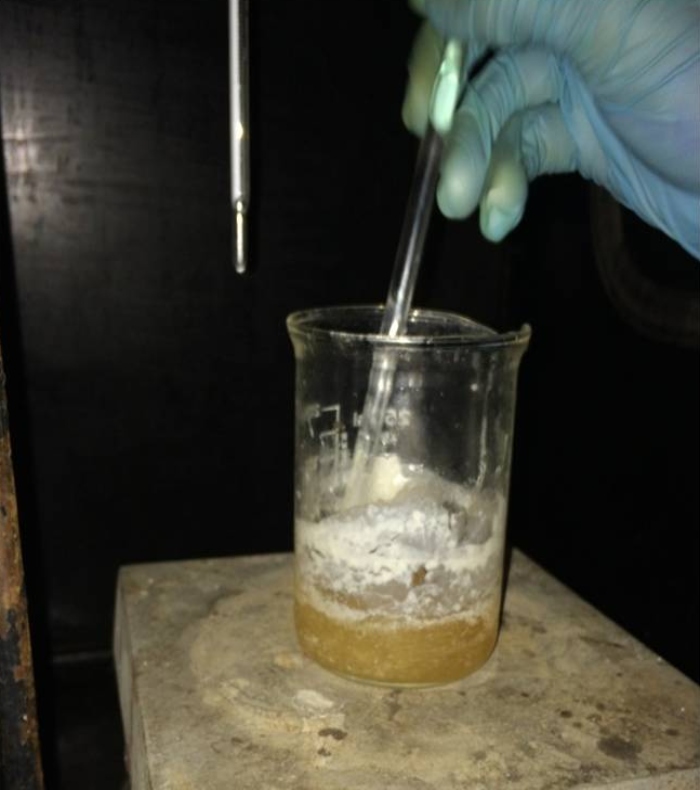
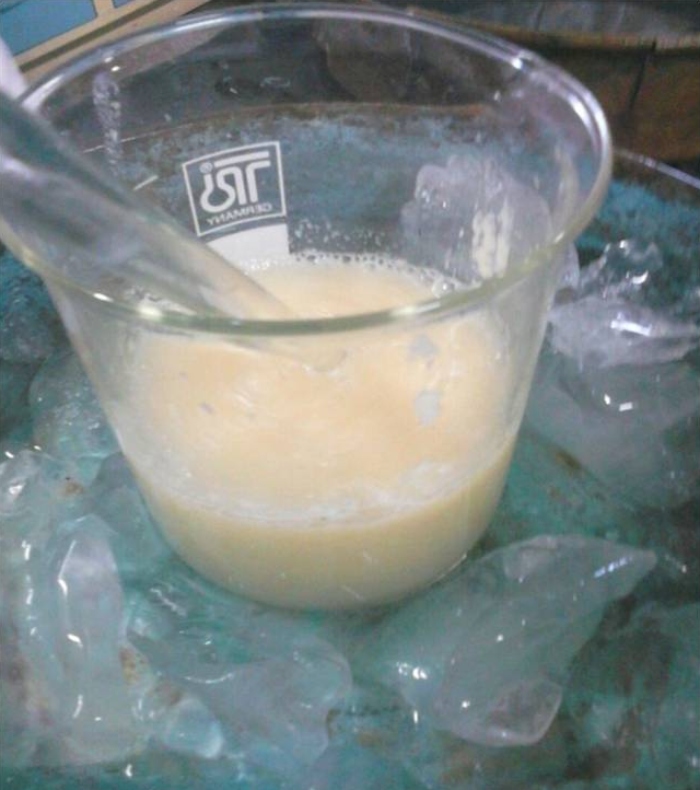
➝ Una vez con todos los ingredientes necesarios, procedemos a comenzar la elaboración:
• En uno de los envases vertemos los 200mL de agua.
• Al paso anterior con mucho cuidado, comenzamos a añadir ya pesado 78g de sosa cáustica; esto se realiza lento de manera gradual, para que la reacción se lleve a cabo de manera que se disuelva sosa y la misma agarre calor. (cuidado con los humos producidos por la reacción).
►Nota Importante: Este paso debe hacerse así y nunca al revés, es decir verter el agua a la sosa cáustica; ya que es bastante peligroso.
• Seguimos añadiendo sosa poco a poco, pero esperando a que se disuelva la que vertimos anteriormente. Como la reacción va a ir aumentando la temperatura podemos colocar el envase en una superficie de madera.
• Dejaremos reposar la mezcla de agua y sosa hasta descender la temperatura a 40ºC.
• En una olla calentamos el aceite hasta llevarlo a 40ºC.
• Vertemos el aceite en otro envase, seguidamente la mezcla de sosa y agua la iremos añadiendo; en este proceso notaremos como el aceite va tomando una consistencia espesa y un color opaco.
• Con la paleta de madera incorporaremos toda la mezcla.
• Una vez debidamente mezclado, comenzaremos a proceder a activar la batidora (o a batir manual); con una velocidad constante notaremos que la mezcla toma una consistencia espesa, seguiremos batiendo hasta que se encuentre en un puto viscoso (por ejemplo la consistencia del puré de papas).
• Este paso es opcional, pero podemos añadir fragancias, colorantes, aceite esencial u otros aditivos para nuestro jabón. Una vez añadido el aditivo de nuestro gusto, removemos la mezcla para homogeneizar la mezcla.
• Vertemos la mezcla en el molde que hayamos escogido, lo llevaremos a un lugar para dejarlo reposar y completar la reacción de saponificación. Lo cubriremos con una toalla y dejamos por 24 horas.
• Transcurrida las 24 horas, desmontamos de los moldes; ya formados los dejaremos al aire libre envueltos con papel absorbente para que se sequen del todo y se endurezcan. Deberían permanecer en secado más de 15 días para que se complete la neutralización (aunque ya luego de una semana se puede usar).
Once with all the necessary ingredients, we proceed to begin the preparation:
• In one of the containers we pour the 200mL of water.
• In the previous step, very carefully, we began to add a heavy 78g of caustic soda; This is done slowly gradually, so that the reaction is carried out so that soda dissolves and it seizes heat. (Be careful with the fumes produced by the reaction).
►Important Note: This step should be done like this and never the other way around, that is, pour the water into the caustic soda; since it is quite dangerous.
• We continue adding soda little by little, but waiting for the one we previously poured to dissolve. As the reaction will increase the temperature, we can place the container on a wooden surface.
• Let the water and soda mixture rest until the temperature drops to 40ºC.
• In a pot we will heat the oil until it reaches 40ºC.
• We pour the oil into another container, then we will add the soda and water mixture; In this process we will notice how the oil takes on a thick consistency and an opaque color.
• With the wooden palette we will incorporate all the mixture.
• Once properly mixed, we will begin to activate the mixer (or to beat manually); With a constant speed we will notice that the mixture takes a thick consistency, we will continue beating until it is in a fucking viscous (for example the consistency of mashed potatoes).
• This step is optional, but we can add fragrances, colorants, essential oil or other additives to our soap. Once the additive of our liking has been added, we stir the mixture to homogenize the mixture.
• We pour the mixture into the mold that we have chosen, we will take it to a place to let it rest and complete the saponification reaction. We will cover it with a towel and leave it for 24 hours.
• After 24 hours, we disassemble the molds; Once formed, we will leave them in the open air wrapped with absorbent paper so that they dry completely and harden. They should remain in drying for more than 15 days for the neutralization to be completed (although after a week it can be used).
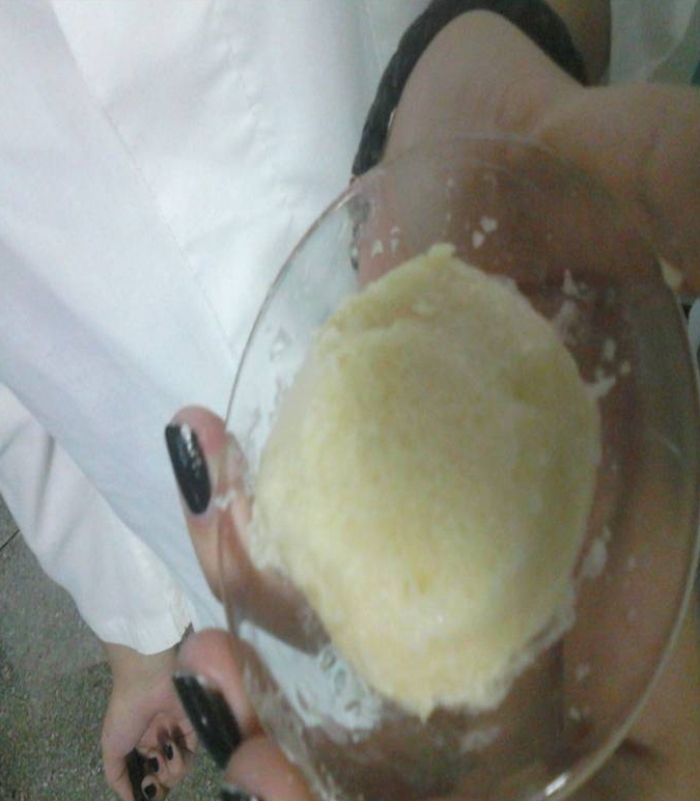

Me despido y espero que les haya gustado este post amigos, los dejo con de la receta para que disfruten realizando jabón en casa (aunque a nivel de laboratorio se efectúan unos pasos más detallados) y me cuenten que tal les fue haciéndola. Un abrazo fuerte a través de estas letras.
I say goodbye and I hope you liked this post friends, I leave you with the recipe so that you can enjoy making soap at home (although at the laboratory level some more detailed steps are carried out) and tell me how you were doing it. A strong hug through these letters.

NOTA: Todas las fotos y banners sin fuentes son de mi autoría.
►NOTE: All photos and banners without fonts are my own.
Your post has been curated by us! Received 20.00% upvote from @opb. Do consider delegate to us to help support our project.
Do join our discord channel to give us feedback, https://discord.gg/bwb2ENt
* This bot is upvoting based on the criteria : 1. Not plagiarised, 2. Persistent previous quality posts, 3. Active engagement with other usersDo upvote this commment if you 💚 our service :)
Thank you so much @opbc